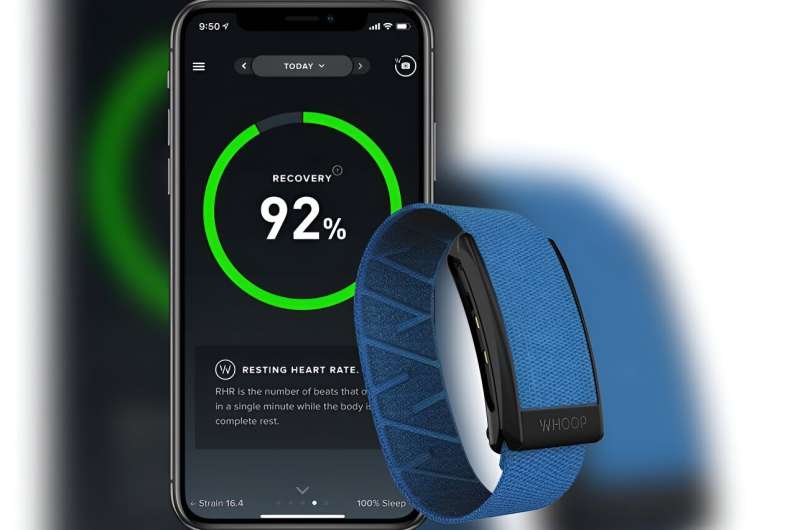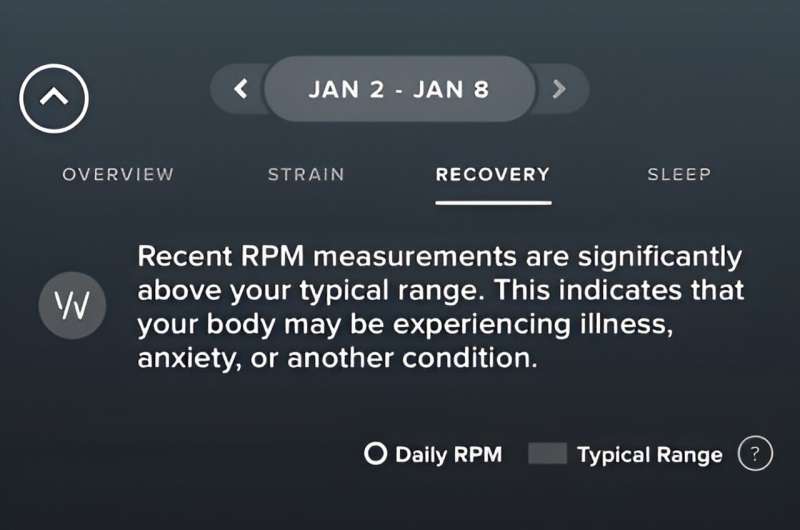This article has been reviewed according to Science X's editorial process and policies. Editors have highlighted the following attributes while ensuring the content's credibility:
fact-checked
trusted source
proofread
Wearable technology shows promise in early detection of COVID-19 among athletes

In a study conducted by Florida State University, wearable technology has emerged as a potential game-changer in the early detection of COVID-19 among NCAA Division I female student-athletes.
The research by FSU Professor Michael Ormsbee, Assistant Athletic Director of Sport Performance Elisa Angeles and doctoral candidate Liliana Rentería in the Institute of Sports Sciences and Medicine (ISSM) focused on the use of WHOOP bands, which use optical sensors to measure and predict how fast your heart beats, how often you breathe, how you sleep and then use that information to calculate your strain and recovery.
The ISSM research team, which works closely with athletes, monitored 113 NCAA Division I female student-athletes in soccer, golf, softball, indoor volleyball, beach volleyball and tennis. The athletes were equipped with WHOOP bands over a 10-month period, from August 2020 to May 2021. The results are published in the journal Sports Health: A Multidisciplinary Approach.
The project started when Angeles, who is also the associate director of Athletics Research for ISSM, noticed changes in what her student-athletes' WHOOP bands were recording. There were several examples where Angeles suspected something based on the data, said Ormsbee, director of the ISSM.
"One day, after reviewing recovery data and noticing a clear outlier and suspected potential COVID infection, Angeles immediately consulted with Sports Medicine staff to urgently send the student-athlete for testing and quarantine," Ormsbee said.

"At that point in time, that student-athlete just arrived at a team function/watch party for the Olympics. Sure enough, she tested positive for COVID. However, because of the swift identification and action, no additional team members were contact-traced or quarantined, and no additional team or staff members contracted COVID via that event."
The WHOOP band monitoring allowed the researchers to establish baseline levels for heart rate variability (HRV), resting heart rate (RHR), respiratory rate (RR) and recovery. Researchers observed how the student-athletes' metrics changed in the days leading up to a positive COVID-19 test and saw that respiratory rate increased three days before a positive test.
Of the student-athletes monitored, 33 eventually tested positive for COVID. RHR and HRV, on the other hand, did not show significant changes until one day before the positive test.
Recovery, a metric often tracked by athletes, didn't significantly change until the day of the positive COVID-19 test, making it less effective as an early detection tool.
As a result, the researchers recommend using an elevated RR as the primary alert for a possible COVID-19 infection.
The study underscores the importance of educating athletes and coaching staff about the significance of monitoring RR, HRV, RHR and recovery throughout the season to ensure early detection and timely intervention in cases of infection, the researchers said.
"Because athletes work in such close quarters, transmission of disease is very easy and it's important to try and mitigate the spread, so you don't lose a decent portion of the team for games or practice," said Rentería, the study's lead author. "This means less chance of spreading COVID to other individuals across the board—not just fellow athletes, but friends and family too."
Rentería said she thinks wearable technology will play a significant role in health monitoring beyond athletics and COVID-19.
"We already see wearable technology being implemented in some doctors' offices, which is great," she said. "I think we will see a lot more of this in the upcoming years, which will help doctors get a better picture of what each individual's normal metrics are, as everyone is a little different. This way people are able to notice deviations from their own normal, which may indicate something is wrong before symptoms become too severe."
More information: Liliana I. Rentería et al, Early Detection of COVID-19 in Female Athletes Using Wearable Technology, Sports Health: A Multidisciplinary Approach (2023). DOI: 10.1177/19417381231183709



















